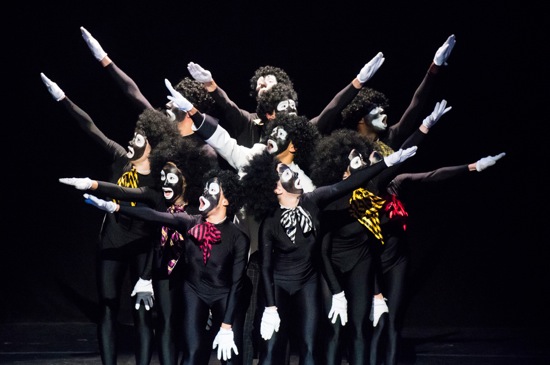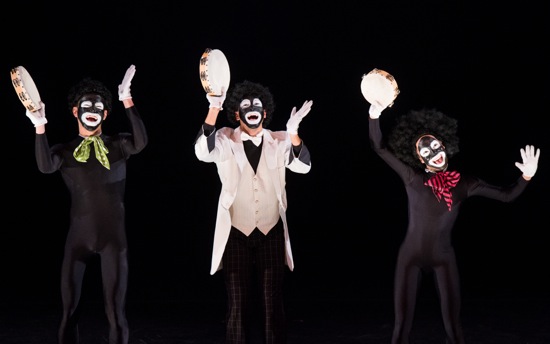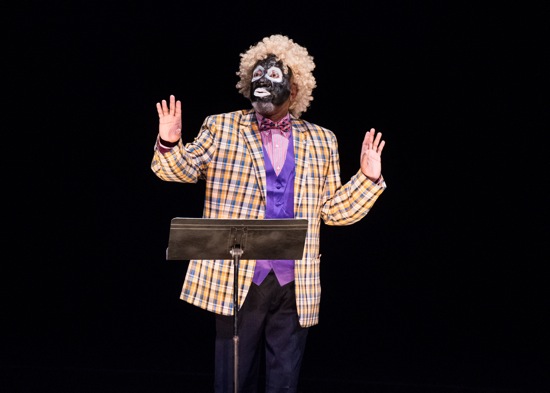Spectrum Dance Theater brings Donald Byrd’s The Minstrel Show Revisited to NYU Skirball Center.
Eleven dancers take the stage at NYU Skirball Center in Donald Byrd’s The Minstrel Show Revisited. They’re strutting, prancing, raising white-gloved hands. How come I don’t recognize any faces? I can hardly tell which are women and which are men. Byrd has already made a point about racial prejudice; it may change its forms over the years, but it doesn’t vanish.
The members of Byrd’s Seattle-based Spectrum Dance Theater are disguised by exaggerated blackface and frizzy black wigs, and they all wear long-sleeved black unitards, over which they sometimes don skirts or overalls or floppy neck scarves. In Part Two of the work, when the gifted, versatile performers appear without the makeup and wigs, they reveal themselves as a racially diverse bunch of people.
One of the messages implicit in the minstrel shows that began decades before the Civil War erupted was that all “negroes” looked pretty much alike to white folks, and the white minstrels who put on blackface played them as sly but foolish buffoons who could tell jokes, cut capers, and play banjos, tambourines, and bones. (Savvy black men got in on the profession too, creating a double illusion by imitating white men’s jokey stereotypes of blacks.)
In revising his fiercely political and moral 1991 The Minstrel Show, Byrd has incorporated more recent events that illustrate in contemporary terms the corrosive they-all-look-alike fallacy: the shooting of unarmed African Americans, such as Michael Brown and Trayvon Martin, by police who are convinced that they must be up to no good and surely have guns in their pockets.
The Minstrel Show Revisited begins with one of its most haunting images. A man in minstrel-show disguise (the superb Alex Crozier) stands downstage center in a pool of light surrounded by darkness. He’s erect, dignified, and only his mouth moves as he spits out the lyrics of an old Ragtime hit, separating each word by a pause, turning a text that was written in dialect into an elocution exercise: “There’ll. be. a. hot. time. in. the. old. town. tonight.” Once that’s done, he’s joined by two women, and the “show” begins.
Byrd’s choreography refers to and ingeniously transforms choreographic elements of minstrelsy, along with popular dance forms of the 19th century. One number makes artful use of tambourines. Loose-limbed “eccentric” dancing, acrobatic stunts, soft-shoe displays, the hornpipe, the lindy, and the cakewalk mingle with grand-right-and-lefts, waltzes, and allusions to other theatrical forms. Davione Gordon does backflips across the stage. Alexis “Tilly” Evans Krueger executes (brilliantly) a very balletic little solo, complete with diva bows. Once, when the dancers are clustered centerstage, the tallest man at the back wings his arms above the others for a second, invoking the penultimate moment in the “I Been Buked” section of Alvin Ailey’s Revelations (not a work that ventures anywhere near social criticism). Mio Morales’s recorded score (which was played live back in 1991) accompanies the dancing. I hadn’t realized until now how many musical variations the composer wrung out of “There’ll be a hot time. . . .”
Jokes keep company with demeaning epithets of all sorts. Crozier delivers a rapid stream of slang that spans race, nationality, and religion (“kike,” “nigger,” “polack,” “greaser,” “spic,”and many, many more). The ensemble gets in on the act. Byrd, who shares (sort of) the role of minstrelsy’s Interlocutor with Crozier, comes onstage without makeup in the first section and solicits racist jokes from the audience, asking that people come up onstage to deliver them. He’s charming, but brooks no reticence (“We can be here all night. . .Not really”). The six brave responders flank him as the End Men of minstrelsy, Mr. Tambo and Mr. Bones. They couldn’t have predicted that he’d want them to address him as “Mistah Jaawwnson” and get the pronunciation right, along with the servile bow. The jokes, predictably, aren’t very funny (and they’re hard to hear); a collective wince runs through the audience; disgusted snorts and appalled giggles are heard. In Part 2, Byrd reads jokes submitted on paper during intermission. (The process is a bit trying on this particular night, since he has trouble reading some contributors’ handwriting, and a man in the front row who helps him out isn’t mic’d.)
Byrd is—and has always been—a highly skilled choreographer. He packs dance phrases with intricacies, dynamic shadings, and shifting rhythms. In spite of this, I find myself getting restive during Part 1. Not just because of the relaxed way he handles audience participation, but because there’s a point at which I wish he’d trimmed the dance numbers, so that each one seemed to embed a new surprise. (I could also wish that the music throughout—which includes Scott Joplin’s “Heliotrope Bouquet,” plus selections by Cedaa Remix, Liquid EP, and others—could be reduced in volume when the performers are speaking.)
Byrd himself dons black face and a white wig at one point—perhaps in part to mock scholars who bring their analytic eyes to bear on popular forms. He turns the process into an exercise in erudite futility, as he ponders the nursery rhyme, “Old Mother Hubbard.” But his “lecture” betrays interesting links to his main issue, especially in its last verse (he pontificates only on the first one): The poor “dawg” didn’t get a bone but raised his status without his mistress’s help: “This wonderful dog/ Was Dame Hubbard’s delight,/ He could read, he could dance,/ He could sing, he could write;/ She gave him rich dainties/ Whenever he fed,/ And erected this monument/ When he was dead.”
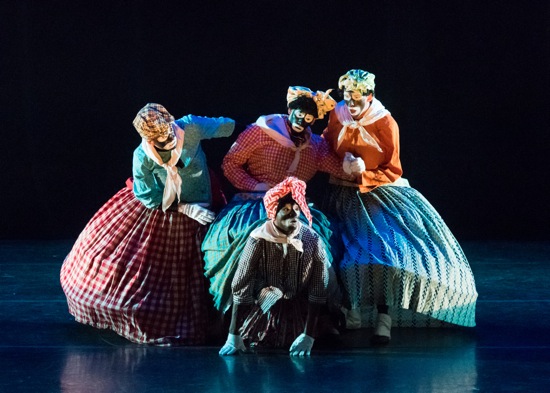
Mammy resurrected. (L to R standing): Fausto Rivera, Micah St. Kitts, and Andrew Pontius, with Davione Gordon peering through. Photo: Ian Douglas
Various scenes in Part 2 of The Minstrel Show Revisited make savage fun of racial stereotypes. Jaclyn Wheately appears sans blackface—white skinned and blond-haired. She’s dressed like a dominatrix (Doris Black’s costumes were inspired by Gabriel Berry’s original ones.) Despite her aggressively sexy black outfit and behavior, she could be standing in for a bored white woman who lures a black man into sex and then accuses him of rape. One of the hapless males she leads around by the nose (almost literally) confront a gigantic member of the Ku Klux Klan (someone sitting on someone else’s shoulder) ends up with a noose around his neck.
Then there are the Mammies. Crozier, channeling Hattie McDaniels, cinches Emily Pihlaja as Scarlett O’Hara into her corset and gown, and folds “her” arms in weary disapproval while the young mistress gets hysterical trying to decide whether she prefers Ashley or Rhett, plus vowing, “I’ll never go hungry again.” Four guys in full Aunt-Jemima outfits gossip, strut, and sway their hips, while “Mammy,” the song Al Jolson made famous, is heard.
In one theatrically chilling vignette, a runaway slave (Gordon minus wig and blackface, his hands tied together) rushes unheeded in and out of the space in which three white women and a man, parade slow motion—one woman paired with the man. The women are hoop-skirted, dressed for a ball or a fancy outing. One of them (Wheatley in a red wig) responds to the frantic slave by running around, weeping, and— when he writhes on the floor—fainting. The others never interrupt their slow, decorous stroll.
Byrd’s principal revision to his 1991 The Minstrel Show consists of a hard-eyed look into the interrogation of neighborhood watch captain George Zimmerman for the shooting of Trayvon Martin in 2012. By this point, all the performers except Crozier are no longer in minstrel makeup and attire. The whole cast sits on chairs arranged in a semi-circle (as in a minstrel show); each person holds a tambourine, which he or she strikes to accentuate the unemotional, featureless voices of Andrew Pontius as Zimmerman and Madison Oliver as the detective questioning him, as they read from transcripts. Pontius also leaves his chair to take on the role of shooter, while Gordon embodies his victim. They reenact the confrontation as the others cluster, then clear the stage.
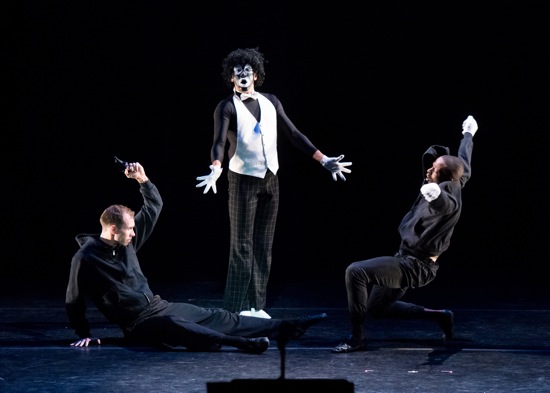
(L to R) Andrew Pontius, Alex Crozier, and Davione Gordon in The Minstrel Show Revisited. Photo: Ian Douglas
Byrd wants to drum the horror, the prejudices, and the stereotyping into our heads. I understand that urge. A few people walk out over the course of the show. Are they offended? Bored? Tired? Hard to say. His last act is to hold the stage alone and read the appallingly long list of African Americans who were unnecessarily slain by police; a number of the killers served no jail time. (I wish those names and dates had been projected on the back wall to seal the facts in memory.)
Fact and fiction, truth and flawed recollections have distorted the history of prejudice in this supposed democracy in which all men and women are equal. The “happy, well-treated darkie” image of the antebellum South was but one mask imposed upon people who had been bought in Africa, brought across the ocean packed in below decks like sardines, sold at auction, and often separated from the children they bore on American soil. Minstrel shows exploited them, made jokes about them, and promulgated a stereotype in the name of entertainment. Other kinds of stereotypes have persisted, despite efforts to combat discrimination. One is that of the black dude who surely has a gun in his pocket and shouldn’t be walking where he’s walking when he feels like walking. The tremendously skilled and valiant performers in Spectrum Dance Theater assist Byrd—by turns avuncular, tough, and not afraid to offend—in shaking all sleepers awake to that fallacy.

